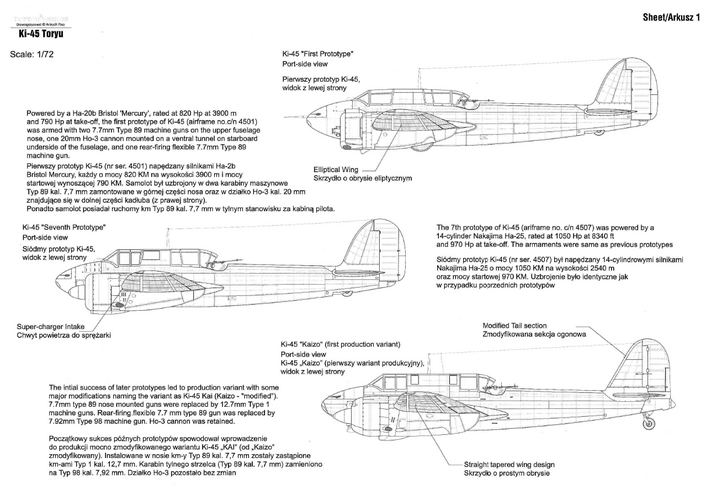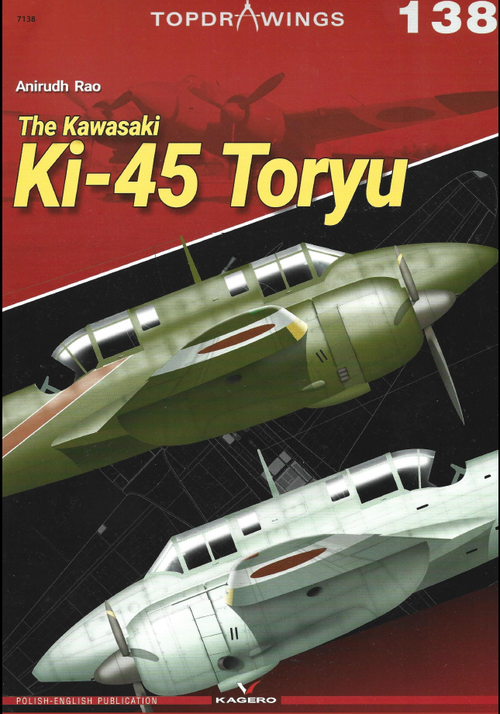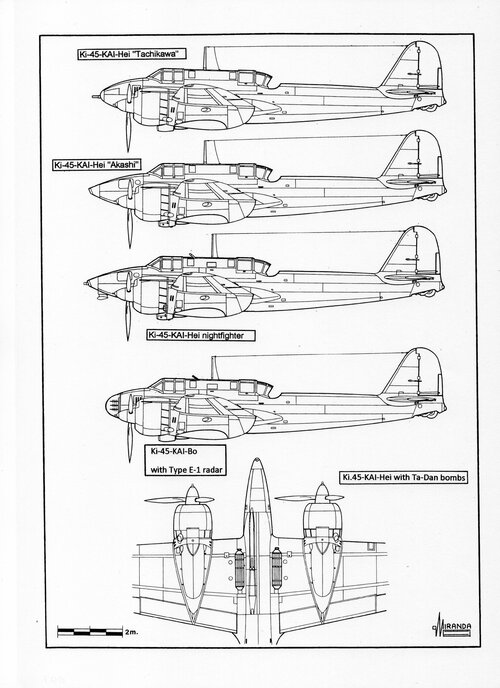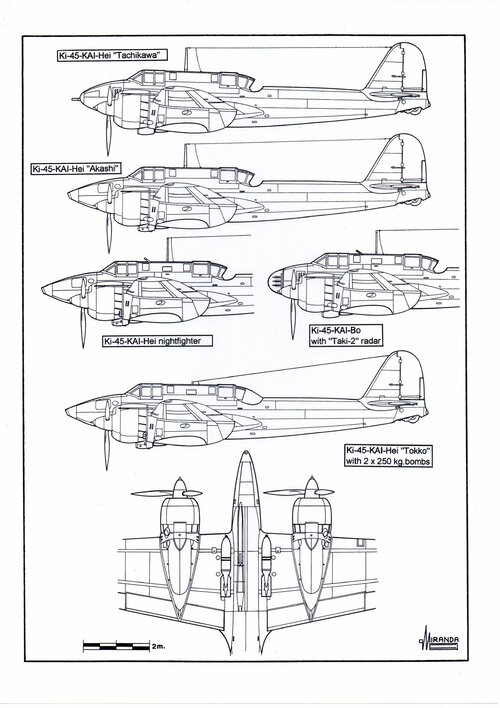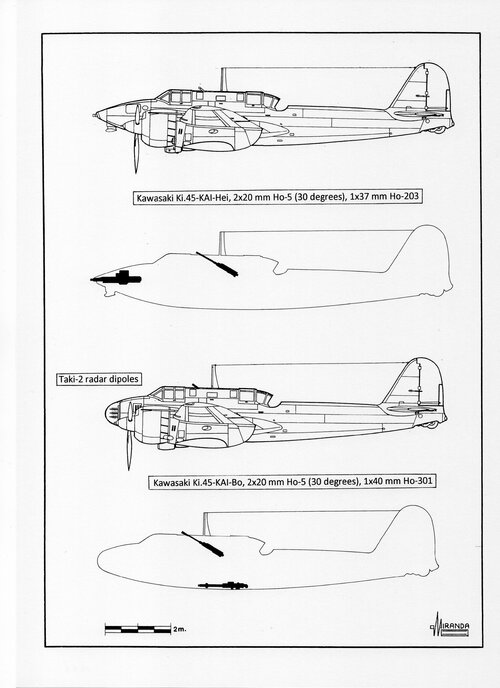You are using an out of date browser. It may not display this or other websites correctly.
You should upgrade or use an alternative browser.
You should upgrade or use an alternative browser.
Kawasaki Ki-45 Projects, Prototypes & Variants
- Thread starter Justo Miranda
- Start date
- Kawasaki Ki.45 Toryu
The writings of Giulio Douhet had convinced many influential persons in the mid-1930s that future wars would be won from the air by large fleets of bombers. But the combat experience gained in Spain and China clearly indicated that the bombers had to be escorted by fighters to be effective.
The limited range of the fighters of the time restricted the territorial ambitions of the countries a little over 300 km beyond its borders, but Germany dreamt of the Urals, Italy dreamt of Egypt and Japan of China.
.
Trying to overcome that limit was how the concept Zerstörer was conceived, a heavy fighter with powerful weapons and high range in which the Axis Powers invested large resources with more ideological than scientific basis. When the realities of war and the laws of physics were imposed over London in the summer of 1940, Göring was shocked to hear that his heavy Messerschmitt Bf 110 could not hunt the Hurricanes because these could make tighter turns. The Italians had similar luck with the Romeo 58 and Savoia 91 that never reached the production stage. Göring persevered in this error favouring the construction of three hundred units of the Messerschmitt Me 210, whose design flaws cost three million Reichsmarks and a major national scandal.
In Japan, the IJA ordered the design of the Kawasaki Ki.45, inspired by the operational philosophy of the Bf 110. After many tests using prototypes, the Ki.45-KAI-Ko entered service armed with two machine guns in the nose and one cannon of 20 mm in a ventral tunnel. Over the course of its first combat over Kweilin-China, on 12 June1942, five Toryus of the 84th Chutai faced five Tomahawks of the AVG, losing three to zero. According to reports coming from the fighting in Burma - where the Ki.45 of the 21st Sentai faced the British Hurricane Mk.IIA and Mohawks Mk. IV - the IJA realized that the Toryu was not able to fight against single engine fighters.
The Ki.45 could face the British Beaufighters in New Guinea with dignity but it was almost impossible for this aircraft to bring them down, because of the low rate of fire of its antique cannon. The production of the Ki.45 was then reoriented towards ground attack specialized versions like the Ki.45-KAI-Otsu. This aircraft had a new 20mm cannon Ho-3 with a 50-round magazine in the nose and a 37 mm cannon Type 94, manually loaded, with a low rate of fire, in the ventral tunnel. It could carry two Type 98, number 25 land bombs of 242.2 kg under the wings.
Both the ‘Ko’ and the ‘Otsu’ versions were widely used in New Guinea, China and Malaya against trains, patrol torpedo boats and landing ships. In 1943 the surviving aircraft were sent to flight schools and replaced in combat units by the Ki.45-KAI-Hei. In this version, the 37 mm cannon was the Ho-203 automatic model with 25 rounds magazine and was in the nose. The ventral tunnel carried a Ho-3 of 20 mm. The ‘Hei’ retained the ability to carry two bombs of 250 kg.
All the airplanes of this model manufactured by the Tachikawa Arsenal had the barrel visible, protruding from the rounded extreme nose, while those manufactured by Akashi were covered by a conical fairing. The ‘Hei’ proved very useful in the fight against the Liberators, achieving some successes during the first months of 1943. When American bombers began to be escorted by Lightning fighters, the Ki.45 again performed ground attack missions. During the summer, the Ki.45 of the 5th, 13th and 45th Sentais suffered heavy losses against the 2nd generation fighters of the Corsair and Thunderbolt type, newcomers to New Guinea.
After receiving reports on the construction of airfields for the B-29 in China, the IJA began preparations for the defence of the Japanese mainland. The evaluation of the ‘Hei’ showed that the aircraft possessed good flight performances at high altitude, could fight using all its weapons between 8,200 and 9,750 m, without losing manoeuvrability, and up to 10,200 m with some weight loss, although it took it too long to reach that altitude.
On 15 June 1944, during a night raid on Yawata by the B-29 of the 468th BG, the ‘Limber Dragon’ 42-6230 was shot down by a Ki.45 of the 4th Sentai, piloted by Lt. Sadamitsu Kimura. On 29 July, the B-29 BS 42-6275 of the 794th BS, was shot down over Chengshen-China by a Ki.45 of the 25th Sentai. On 7 December, the ‘Round Trip Ticket’ 42-6262 of the 678th BS, was shot down over Manshu-Mukden by another Ki.45 of the 25th Sentai. On 22 January 1945, during an attack on the Nakajima factory of Tokyo, the ‘Rover Boy Express’ 42-24769 was downed near Konoike by a Hei of the 4th Sentai piloted by Isamu Kashiide. On 4 February, a Ki.45 of the 4th Sentai downed the ’Devil's Darling’ 42-24629 over Kobe. On 5 June, the 42-69665 was downed by a Ki.45 of the 53rd Sentai also over Kobe.
Some of these victories were achieved via frontal attacks by firing against the cockpit of the bomber from a distance of 100 m, or by 45 degrees diving against the engines. When the IJA ordered every Sentai of air defence to create an Air Superiority Company specializing in ramming, some ‘Hei’ were expressly modified by removing the armaments to make them lighter.
The Ki.45 proved to be very suitable as rammer because it had fast diving features that were superior to those of any other Japanese fighter. It was also very resistant to battle damage, especially when armoured plates were installed to protect the pilot. In this version, the radio operator was removed, and the rear opening of the cockpit was coated with metal plates. Even with its weight reduction, the Ki.45 weighed more than twice a Ki.44 which allowed him to cause much greater structural damage during collision.
In early March 1945, the B-29s began a series of low altitude night raids against the 67 major cities in Japan that were devastating. Despite what happened in Germany, the IJA had not foreseen the need to build specialized night fighters. Taken by surprise by the change in strategy of the Americans, the pilots of the Ki.45 improvised some night technical interception techniques, coordinating their attacks with the ground searchlights regiments. They also used a B-17 caught in Bandung for nocturnal visual localization practices. Some ‘Hei’ aircraft suffered field transformations for night fighting, fitting them with two Ho-5 guns of 20 mm angled at 35 degrees in Schräge Musik configuration.
The fires lit the undersides of the B-29s making them visible to the pilots of Toryus, Gekkos and Zeros that waited the opportunity of destroying them at a low-altitude firing at their belly from close range. When at the end of May 1945, the Superfortress came to the imperial capital city escorted by numerous Mustangs based on Iwo Jima, the Ki.45 survivors were sent on Tokko missions.
Attachments
Kawasaki Ki.45 Toryu
By early March 1945, the B-29s began a series of low altitude night raids against the 67 major cities in Japan that were devastating. Despite what happened in Germany, the IJA had not foreseen the need to build specialized night fighters. Taken by surprise by the strategy change by the Americans, the pilots of the Ki.45 improvised some night technical interception techniques, coordinating their attacks with the ground searchlights regiments. They also used a B-17 caught in Bandung for nocturnal visual localization practices. Some Ki.45-KAI-Hei aircraft underwent field transformations for night fighting, fitting them with two Ho-5 guns of 20 mm in a 35 degrees Schräge Musik configuration and one 37 mm Ho-203 cannon in the nose.
The fires lit the undersides of the B-29s making them visible to the pilots of Toryus, Gekkos, Raidens and Zeros that waited the opportunity of destroying them at a low-altitude firing at their belly from close range. This version was called Ki.45-KAI-Bo and was armed with a non-standard Ho-301, 40 mm cannon in the ventral tunnel and two Ho-5 guns of 20 mm in 70 degrees angle Schräge Musik configuration. In 1945 at least twelve Toryus were equipped with one TAMA Taki-2 Model II AI radar, with the antennae installed in a transparent nose cone, operating in 80 cm wavelength. This version was called Ki.45-KAI-Bo and was armed with a non-standard Ho-301, 40 mm cannon in the ventral tunnel and two Ho-5 guns of 20 mm in 70 degrees Schräge Musik configuration.
Ki.45-KAI-Bo technical data
Wingspan: 15.02 m, length: 10.51 m, height: 3.70 m, wing area: 32 sq. m, max weight: 5,500 kg, max speed: 547 kph, estimated service ceiling: 10,000 m.
By early March 1945, the B-29s began a series of low altitude night raids against the 67 major cities in Japan that were devastating. Despite what happened in Germany, the IJA had not foreseen the need to build specialized night fighters. Taken by surprise by the strategy change by the Americans, the pilots of the Ki.45 improvised some night technical interception techniques, coordinating their attacks with the ground searchlights regiments. They also used a B-17 caught in Bandung for nocturnal visual localization practices. Some Ki.45-KAI-Hei aircraft underwent field transformations for night fighting, fitting them with two Ho-5 guns of 20 mm in a 35 degrees Schräge Musik configuration and one 37 mm Ho-203 cannon in the nose.
The fires lit the undersides of the B-29s making them visible to the pilots of Toryus, Gekkos, Raidens and Zeros that waited the opportunity of destroying them at a low-altitude firing at their belly from close range. This version was called Ki.45-KAI-Bo and was armed with a non-standard Ho-301, 40 mm cannon in the ventral tunnel and two Ho-5 guns of 20 mm in 70 degrees angle Schräge Musik configuration. In 1945 at least twelve Toryus were equipped with one TAMA Taki-2 Model II AI radar, with the antennae installed in a transparent nose cone, operating in 80 cm wavelength. This version was called Ki.45-KAI-Bo and was armed with a non-standard Ho-301, 40 mm cannon in the ventral tunnel and two Ho-5 guns of 20 mm in 70 degrees Schräge Musik configuration.
Ki.45-KAI-Bo technical data
Wingspan: 15.02 m, length: 10.51 m, height: 3.70 m, wing area: 32 sq. m, max weight: 5,500 kg, max speed: 547 kph, estimated service ceiling: 10,000 m.
Attachments
Similar threads
-
-
-
Kawasaki Ki-119 Experimental Fighter-Bomber
- Started by blackkite
- Replies: 12
-
-
Kawasaki Ki-102 ("Randy") variants and Ki-108
- Started by Winston
- Replies: 53

